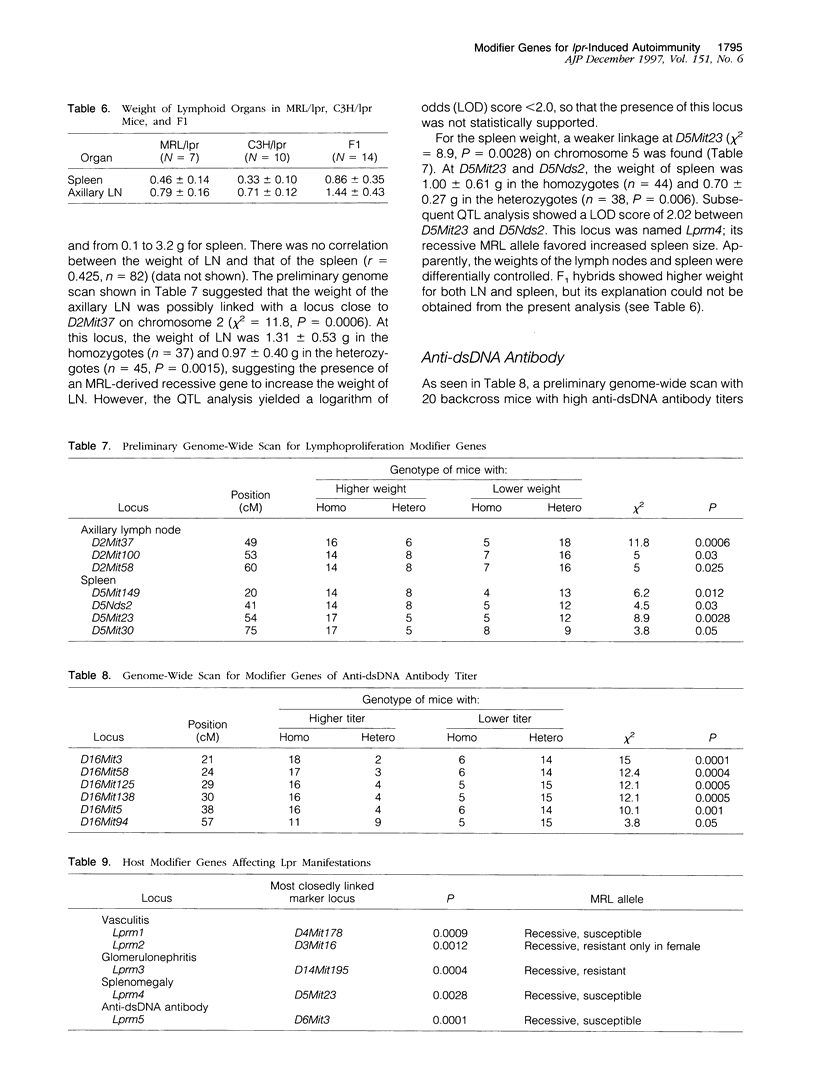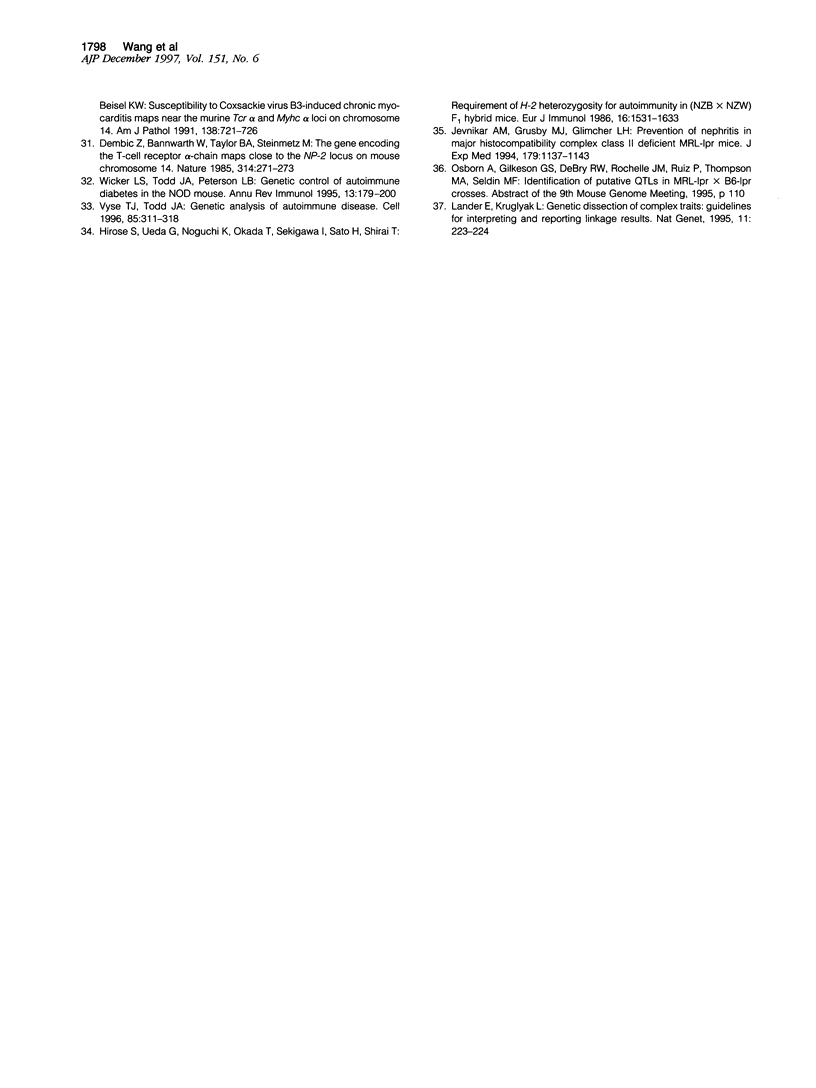Abstract
A defect in apoptotic signal transmission through CD95 is an essential genetic mechanism for lymphoproliferation and autoimmunities in lpr or gld mice. However, disease manifestations are largely affected by the host genetic background. To identify and map such host genes modifying lpr gene effect, ie, the lpr modifier (Lprm) genes, 82 MRL/lpr x (MRL/lpr x C3H/lpr) F1 mice were subjected to immunopathological and genetical analyses. High-grade vasculitis and glomerulonephritis among backcross mice were observed in separate groups of mice. Microsatellite analysis revealed that there were two host genes affecting the occurrence of vasculitis, Lprm1 (chromosome 4) and Lprm2 (chromosome 3). A recessive MRL allele at Lprm1 enhanced vasculitis to occur in both sexes, whereas that of Lprm2 inhibited its development selectively in females. Genotype combinations of these two genes explained the severity of vasculitis in crosses of MRL/lpr and C3H/lpr mice and also the vasculitis-prone recombinant inbred strain McH5/lpr. A recessive MRL allele at Lprm3 (chromosome 14) suppressed glomerulonephritis. The weight of the spleen was increased by a recessive MRL allele at Lprm4 (chromosome 5) yielding a logarithm of odds score of 2.02 in a quantitative trait locus analysis. In contrast, the weight of axillary lymph nodes was increased by a recessive MRL allele at a locus on chromosome 2, but its presence was not supported by the quantitative trait locus analysis. The titer of anti-dsDNA autoantibody was controlled by the locus Lprm5 on chromosome 16, which had an logarithm of odds score of 3.41. Possible candidate genes for Lprm genes deduced from their map locations are discussed and compared with the autoimmunity genes reported thus far. In conclusion, autoimmune disease manifestations by the lpr mutation are affected by multiple host genes separately.
Full text
PDF







Selected References
These references are in PubMed. This may not be the complete list of references from this article.
- Adachi M., Watanabe-Fukunaga R., Nagata S. Aberrant transcription caused by the insertion of an early transposable element in an intron of the Fas antigen gene of lpr mice. Proc Natl Acad Sci U S A. 1993 Mar 1;90(5):1756–1760. doi: 10.1073/pnas.90.5.1756. [DOI] [PMC free article] [PubMed] [Google Scholar]
- Andrews B. S., Eisenberg R. A., Theofilopoulos A. N., Izui S., Wilson C. B., McConahey P. J., Murphy E. D., Roths J. B., Dixon F. J. Spontaneous murine lupus-like syndromes. Clinical and immunopathological manifestations in several strains. J Exp Med. 1978 Nov 1;148(5):1198–1215. doi: 10.1084/jem.148.5.1198. [DOI] [PMC free article] [PubMed] [Google Scholar]
- Berden J. H., Hang L., McConahey P. J., Dixon F. J. Analysis of vascular lesions in murine SLE. I. Association with serologic abnormalities. J Immunol. 1983 Apr;130(4):1699–1705. [PubMed] [Google Scholar]
- Boyer M. H., Hoff R., Kipnis T. L., Murphy E. D., Roths J. B. Trypanosoma cruzi: susceptibility in mice carrying mutant gene lpr (lymphoproliferation). Parasite Immunol. 1983 Mar;5(2):135–142. doi: 10.1111/j.1365-3024.1983.tb00731.x. [DOI] [PubMed] [Google Scholar]
- Cohen P. L., Eisenberg R. A. Lpr and gld: single gene models of systemic autoimmunity and lymphoproliferative disease. Annu Rev Immunol. 1991;9:243–269. doi: 10.1146/annurev.iy.09.040191.001331. [DOI] [PubMed] [Google Scholar]
- Dembić Z., Bannwarth W., Taylor B. A., Steinmetz M. The gene encoding the T-cell receptor alpha-chain maps close to the Np-2 locus on mouse chromosome 14. Nature. 1985 Mar 21;314(6008):271–273. doi: 10.1038/314271a0. [DOI] [PubMed] [Google Scholar]
- Drake C. G., Rozzo S. J., Hirschfeld H. F., Smarnworawong N. P., Palmer E., Kotzin B. L. Analysis of the New Zealand Black contribution to lupus-like renal disease. Multiple genes that operate in a threshold manner. J Immunol. 1995 Mar 1;154(5):2441–2447. [PubMed] [Google Scholar]
- Hirose S., Tsurui H., Nishimura H., Jiang Y., Shirai T. Mapping of a gene for hypergammaglobulinemia to the distal region on chromosome 4 in NZB mice and its contribution to systemic lupus erythematosus in (NZB x NZW)F1 mice. Int Immunol. 1994 Dec;6(12):1857–1864. doi: 10.1093/intimm/6.12.1857. [DOI] [PubMed] [Google Scholar]
- Hirose S., Ueda G., Noguchi K., Okada T., Sekigawa I., Sato H., Shirai T. Requirement of H-2 heterozygosity for autoimmunity in (NZB X NZW)F1 hybrid mice. Eur J Immunol. 1986 Dec;16(12):1631–1633. doi: 10.1002/eji.1830161226. [DOI] [PubMed] [Google Scholar]
- Itoh N., Yonehara S., Ishii A., Yonehara M., Mizushima S., Sameshima M., Hase A., Seto Y., Nagata S. The polypeptide encoded by the cDNA for human cell surface antigen Fas can mediate apoptosis. Cell. 1991 Jul 26;66(2):233–243. doi: 10.1016/0092-8674(91)90614-5. [DOI] [PubMed] [Google Scholar]
- Izui S., Kelley V. E., Masuda K., Yoshida H., Roths J. B., Murphy E. D. Induction of various autoantibodies by mutant gene lpr in several strains of mice. J Immunol. 1984 Jul;133(1):227–233. [PubMed] [Google Scholar]
- Jevnikar A. M., Grusby M. J., Glimcher L. H. Prevention of nephritis in major histocompatibility complex class II-deficient MRL-lpr mice. J Exp Med. 1994 Apr 1;179(4):1137–1143. doi: 10.1084/jem.179.4.1137. [DOI] [PMC free article] [PubMed] [Google Scholar]
- Kono D. H., Burlingame R. W., Owens D. G., Kuramochi A., Balderas R. S., Balomenos D., Theofilopoulos A. N. Lupus susceptibility loci in New Zealand mice. Proc Natl Acad Sci U S A. 1994 Oct 11;91(21):10168–10172. doi: 10.1073/pnas.91.21.10168. [DOI] [PMC free article] [PubMed] [Google Scholar]
- Lander E. S., Green P., Abrahamson J., Barlow A., Daly M. J., Lincoln S. E., Newberg L. A., Newburg L. MAPMAKER: an interactive computer package for constructing primary genetic linkage maps of experimental and natural populations. Genomics. 1987 Oct;1(2):174–181. doi: 10.1016/0888-7543(87)90010-3. [DOI] [PubMed] [Google Scholar]
- Morel L., Rudofsky U. H., Longmate J. A., Schiffenbauer J., Wakeland E. K. Polygenic control of susceptibility to murine systemic lupus erythematosus. Immunity. 1994 Jun;1(3):219–229. doi: 10.1016/1074-7613(94)90100-7. [DOI] [PubMed] [Google Scholar]
- Morse H. C., 3rd, Davidson W. F., Yetter R. A., Murphy E. D., Roths J. B., Coffman R. L. Abnormalities induced by the mutant gene Ipr: expansion of a unique lymphocyte subset. J Immunol. 1982 Dec;129(6):2612–2615. [PubMed] [Google Scholar]
- Nagata S. Fas and Fas ligand: a death factor and its receptor. Adv Immunol. 1994;57:129–144. doi: 10.1016/s0065-2776(08)60672-0. [DOI] [PubMed] [Google Scholar]
- Nose M., Nishimura M., Ito M. R., Toh J., Shibata T., Sugisaki T. Arteritis in a novel congenic strain of mice derived from MRL/Lpr lupus mice: genetic dissociation from glomerulonephritis and limited autoantibody production. Am J Pathol. 1996 Nov;149(5):1763–1769. [PMC free article] [PubMed] [Google Scholar]
- Nose M., Nishimura M., Kyogoku M. Analysis of granulomatous arteritis in MRL/Mp autoimmune disease mice bearing lymphoproliferative genes. The use of mouse genetics to dissociate the development of arteritis and glomerulonephritis. Am J Pathol. 1989 Aug;135(2):271–280. [PMC free article] [PubMed] [Google Scholar]
- Sobel E. S., Kakkanaiah V. N., Rapoport R. G., Eisenberg R. A., Cohen P. L. The abnormal lpr double-negative T cell fails to proliferate in vivo. Clin Immunol Immunopathol. 1995 Feb;74(2):177–184. doi: 10.1006/clin.1995.1026. [DOI] [PubMed] [Google Scholar]
- Takahashi S., Nose M., Sasaki J., Yamamoto T., Kyogoku M. IgG3 production in MRL/lpr mice is responsible for development of lupus nephritis. J Immunol. 1991 Jul 15;147(2):515–519. [PubMed] [Google Scholar]
- Theofilopoulos A. N., Dixon F. J. Murine models of systemic lupus erythematosus. Adv Immunol. 1985;37:269–390. doi: 10.1016/s0065-2776(08)60342-9. [DOI] [PubMed] [Google Scholar]
- Traystman M. D., Chow L. H., McManus B. M., Herskowitz A., Nesbitt M. N., Beisel K. W. Susceptibility to Coxsackievirus B3-induced chronic myocarditis maps near the murine Tcr alpha and Myhc alpha loci on chromosome 14. Am J Pathol. 1991 Mar;138(3):721–726. [PMC free article] [PubMed] [Google Scholar]
- Vyse T. J., Drake C. G., Rozzo S. J., Roper E., Izui S., Kotzin B. L. Genetic linkage of IgG autoantibody production in relation to lupus nephritis in New Zealand hybrid mice. J Clin Invest. 1996 Oct 15;98(8):1762–1772. doi: 10.1172/JCI118975. [DOI] [PMC free article] [PubMed] [Google Scholar]
- Vyse T. J., Todd J. A. Genetic analysis of autoimmune disease. Cell. 1996 May 3;85(3):311–318. doi: 10.1016/s0092-8674(00)81110-1. [DOI] [PubMed] [Google Scholar]
- Watanabe-Fukunaga R., Brannan C. I., Copeland N. G., Jenkins N. A., Nagata S. Lymphoproliferation disorder in mice explained by defects in Fas antigen that mediates apoptosis. Nature. 1992 Mar 26;356(6367):314–317. doi: 10.1038/356314a0. [DOI] [PubMed] [Google Scholar]
- Watson M. L., Rao J. K., Gilkeson G. S., Ruiz P., Eicher E. M., Pisetsky D. S., Matsuzawa A., Rochelle J. M., Seldin M. F. Genetic analysis of MRL-lpr mice: relationship of the Fas apoptosis gene to disease manifestations and renal disease-modifying loci. J Exp Med. 1992 Dec 1;176(6):1645–1656. doi: 10.1084/jem.176.6.1645. [DOI] [PMC free article] [PubMed] [Google Scholar]
- Wicker L. S., Todd J. A., Peterson L. B. Genetic control of autoimmune diabetes in the NOD mouse. Annu Rev Immunol. 1995;13:179–200. doi: 10.1146/annurev.iy.13.040195.001143. [DOI] [PubMed] [Google Scholar]
- Wu J., Zhou T., He J., Mountz J. D. Autoimmune disease in mice due to integration of an endogenous retrovirus in an apoptosis gene. J Exp Med. 1993 Aug 1;178(2):461–468. doi: 10.1084/jem.178.2.461. [DOI] [PMC free article] [PubMed] [Google Scholar]
- Yamada Y., Matsushiro H., Ogawa M. S., Okamoto K., Nakakuki Y., Toyokuni S., Fukumoto M., Hiai H. Genetic predisposition to pre-B lymphomas in SL/Kh strain mice. Cancer Res. 1994 Jan 15;54(2):403–407. [PubMed] [Google Scholar]
- Yonehara S., Ishii A., Yonehara M. A cell-killing monoclonal antibody (anti-Fas) to a cell surface antigen co-downregulated with the receptor of tumor necrosis factor. J Exp Med. 1989 May 1;169(5):1747–1756. doi: 10.1084/jem.169.5.1747. [DOI] [PMC free article] [PubMed] [Google Scholar]


